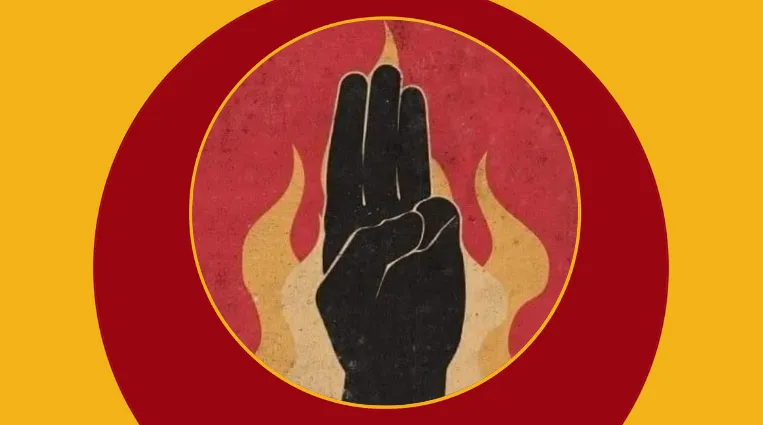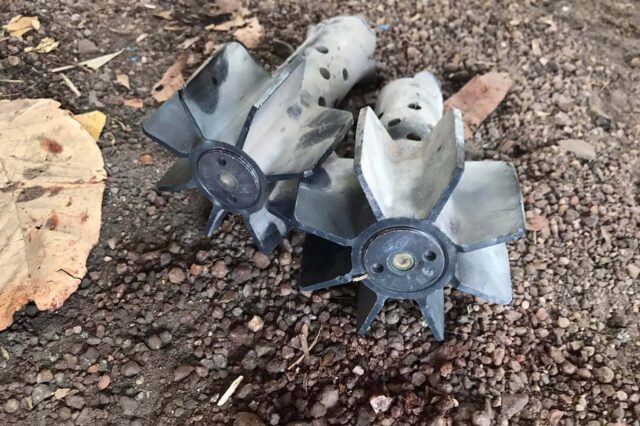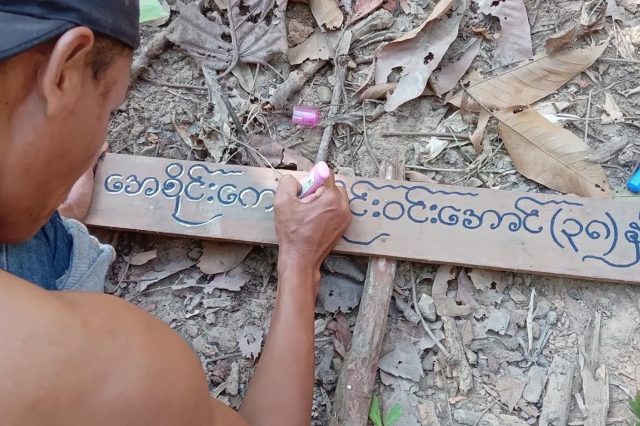Two civilians killed as junta offensive on Thai-Myanmar border continues
27 December 2021


Artillery shells fired by the military on December 25 landed near a camp for displaced villagers and inside Thailand (Karen Information Center)
Both victims were near a camp for displaced civilians when they were killed by heavy artillery fire on Christmas day
By Myanmar Now
At least two civilians were killed on Saturday as Myanmar’s military continued its offensive against anti-regime forces near the Thai-Myanmar border over the Christmas weekend.
The junta used heavy artillery as well as helicopters and a jet fighter to pound targets in territory controlled by the Karen National Union (KNU) in Kayin (Karen) State’s Myawaddy Township, multiple sources told Myanmar Now.
Padoh Saw Taw Nee, the KNU’s foreign affairs officer and spokesperson, confirmed the reports of shelling and airstrikes, but said that none of the group’s troops had been killed or wounded in the attacks.
The two civilian victims were identified as Aung Myo Zin, a 40-year-old cook at a temporary camp for displaced villagers, and 38-year-old A Sai K, the editor of the anti-junta Federal Journal, who had recently fled to the area.
Both men were killed after an artillery shell exploded near a school in Htee Mei Wah Khee, a village that had been sheltering around 400 displaced locals, at around 1pm Saturday, according to witnesses.
“Airplanes flew over at least three times and dropped many bombs. Then the military’s ground troops opened fire with heavy weapons,” said a member of the People’s Defence Force (PDF), which has also been involved in recent clashes in the area.
One man in his 40s—later identified as Aung Myo Zin—was killed instantly, he added.
Friends of the other victim, A Sai K, said they didn’t learn of his death until the following day.
“We scattered after the shell hit and had no idea what was going on. The people who were there didn’t know who he was because he had only recently arrived,” said Soe Ya, the editor-in-chief of the Delta News Agency, who was with A Sai K at the time of the attack.
“We checked the body this morning and realised it was him,” he told Myanmar Now on Sunday.

A friend of A Sai K writes his name on a wooden board as he and other friends prepare to bury his body (Supplied)
Several other people were also injured, including one man whose leg had to be amputated. The total number of casualties could not be confirmed at the time of reporting.
While only two bodies had been discovered as of Sunday, it was possible that others had also been killed, according to Soe Ya.
“These were heavy weapons that exploded near a group of displaced people. More people may have been killed, but we can’t confirm that yet,” he said, adding that at least seven people had suffered head injuries.
According to the PDF member, several artillery shells landed around Htee Mae Wah Khee, including one that exploded at a church that was under construction.
He added that civilians taking shelter in the village were later moved to a safer location.
Following the hour-long attack, the military’s ground troops advanced towards Htee Mae Wah Khee, according to the PDF member and a soldier from the Karen National Liberation Army (KNLA), the armed wing of the KNU.
From 7pm to 3am Sunday, KNLA and PDF troops clashed with the junta army and the Karen Border Guard Force, an ethnic armed group under the command of the Myanmar military, the two sources said.
During the fighting, at least one artillery shell landed on the Thai side of the border, according to a report by Kawkareik Open News.
The shell was fired by the military from the village of Thay Baw Boe, south of Myawaddy, and hit a house in Mawli Chai, a village in Thailand’s Mae Sot Province, the report said.
Meanwhile, local media in Thailand reported that some tanks were seen heading towards the Thai-Myanmar border on Saturday as clashes on the Myanmar side continued.
On December 20, the KNU called on the United Nations to hold an emergency meeting to establish a no-fly zone over the Thai-Myanmar border to prevent the regime from carrying out airstrikes.
Three days later, the junta launched airstrikes on Lay Kay Kaw, a town under the control of the KNLA’s Brigade 6, before carrying out subsequent attacks during the Christmas weekend.
Clashes between the military and the KNLA were triggered by military raids on Lay Kay Kaw on December 14, in which some 30 people, including an MP from the ousted National League for Democracy government, were arrested.
Public Voice Television, a media outlet operated by the shadow National Unity Government, claimed earlier this week that KNLA and PDF fighters had killed at least 68 junta troops, including command-level officers, since the fighting began.
Around 10,000 civilians have been displaced by the deteriorating security situation in the area. Roughly half are believed to have crossed the Moei River into Thailand, where they have received assistance from the Thai authorities.
Written by Tin Htet Paing
Linn Htin contributed to this report
Original Post: Myanmar Now
Announcements
28 February 2025
Asian NGO Network on National Human Rights Institutions , CSO Working Group on Independent National Human Rights Institution (Burma/Myanmar)
Open letter: Removal of the membership of the dis-accredited Myanmar National Human Rights Commission from the Southeast Asia National Human Rights Institution Forum

Progressive Voice is a participatory rights-based policy research and advocacy organization rooted in civil society, that maintains strong networks and relationships with grassroots organizations and community-based organizations throughout Myanmar. It acts as a bridge to the international community and international policymakers by amplifying voices from the ground, and advocating for a rights-based policy narrative.